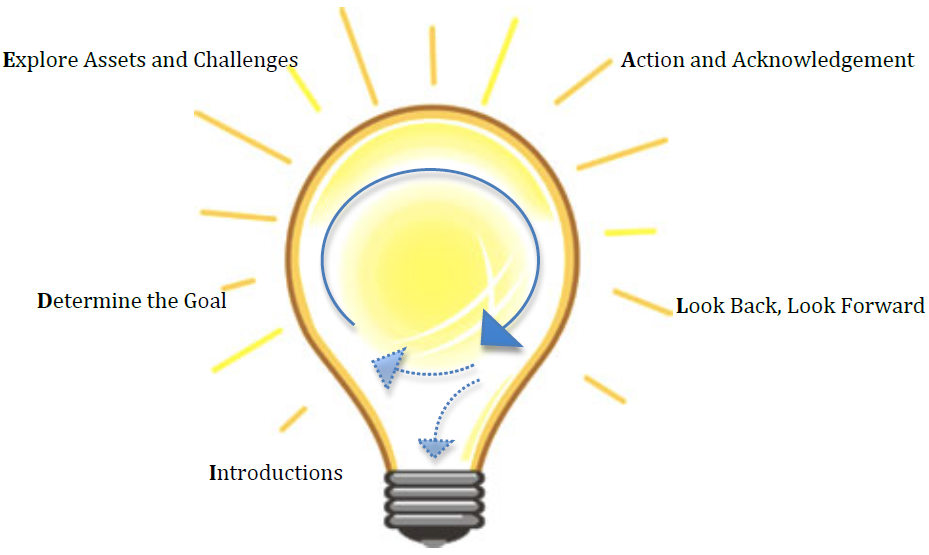A Coaching Model Created by Andrea Kamins
(Career Coach, UNITED STATES)
The IDEAL model helps clients move from their present reality to a more ideal situation. It should be noted that “ideal” is not intended to mean “perfect”. Ideal simply means the right situation at the right time for the client. The IDEAL model helps clients move towards making their ideal life a reality, one goal at a time!
 The phases of the model are:
The phases of the model are:
Introductions, Determine the Goal, Explore Assets and Challenges, Action and Acknowledgment, and Look Back, Look Forward.
Each phase of the model is described below:
Introductions
The first phase is all about the coach and client getting to know each other. An initial discovery questionnaire allows clients to share useful information about their background, personality, values and preferences which can inform the way the coach tailors the process to the client’s needs. The client shares what change she hopes to see as a result of the coaching, and the coach lets the client know what to expect throughout the coaching process.
This is the time when the coach works to begin building trust with the client. One helpful way to do this is to establish a written coaching agreement that clearly outlines what coach and client can expect from one another.
Determine the Goal
Next, the coach has to dig deeper into the client’s goal. What exactly is it that the client hopes to achieve through coaching? A useful tool at this stage is the Design Your Life tool,or other questions/tools that help the client clarify their values and begin to visualize more specifically what their ideal outcome would look like.
The coach needs to understand why this goal matters to the client. Is this a primary goal, or is there something underlying it that the client wants to work on? Once coach and client are both clear on the outcome they are working towards, they can begin to co-‐create a plan of action for achieving it.
Explore Assets and Challenges
Coaches believe that clients are whole and resourceful. This means that the client already possesses all of the resources needed to achieve the goal. The coach’s first job in this phase is to illuminate the assets the client has that will help her reach her desired outcome.
Assets include everything from information to people that can help the client make progress. Examples could include supportive friends who can serve as cheerleaders, access to books or other resources on a relevant subject,a job that provides a temporary paycheck while larger career goals are explored, a gym membership so the client can exercise as a form of self care, a fantastic sense of humor that helps the client stay joyful throughout the process, and countless others.
It is helpful to guide the client in identifying her strengths, describing past and current successes, and looking for experiences in which she may have solved a similar problem or achieved a similar goal to look for “bright spots” that can be replicated in the current situation. The coach can also provide helpful information, resources or feedback as appropriate.
While working towards a goal, it is inevitable that challenges will arise at some point. Sometimes there are challenges that can be seen coming from a mile down the road. In these cases a little advanced planning can spare the client a great deal of stress later on. The coach can help the client identify potential barriers or roadblocks that can be mitigated by a bit of advanced planning.
Challenges can come in the form of events, or they can be internal struggles or patterns of behavior that keep the client feeling “stuck” and unable to make progress. In either case, the coach can support the client in identifying ways to move through or work around these barriers in order to keep moving forward.
One important role a coach plays in this phase is to remind clients that a setback does not have to be a setup for failure. Quite to the contrary! Setbacks can often offer important lessons that ultimately help us in achieving our important goals. The coach can help the client turn challenges into opportunities, and provide support to help the client move through moments of difficulty or frustration.
Action and Acknowledgement
Once the client is aware of the goal, the resources she has available to help her achieve that goal, and a plan for dealing with potential pitfalls, it’s time for action! In this phase, the coach helps the client break large goals into small, manageable action steps so that the client can make steady progress without feeling overwhelmed. During each session, the coach can help the client identify which step(s) are most doable, and can hold the client accountable for the actions she has committed to.
As the client progresses, the coach is right there waiting to cheer her on! This may mean acknowledging the completion of one simple action step, or celebrating a giant accomplishment. In either case, the coach is there to ensure that the client sees (and celebrates!) the progress she is making.
Look Back, Look Forward
Once the client has achieved her goal, the coach and client reflect on what has happened so far. This helps the client recognize and internalize what she has learned about herself throughout the process that can be useful to her in achieving future goals.
The two sets of dotted arrows on the graphic represent where the coach and client may go from here. They may set a new goal, taking them back to the “Determine the Goal” phase, or it may be that the coaching engagement has come to an end and the client is ready to move forward on her own and enjoy her new found success!